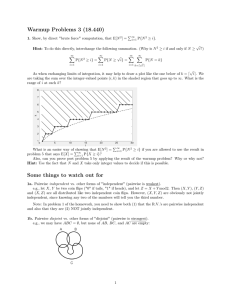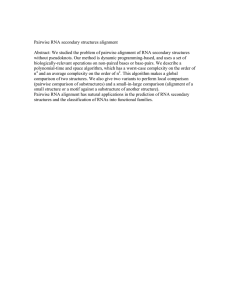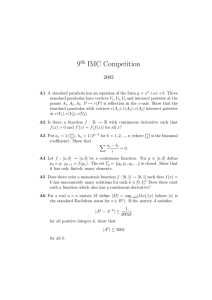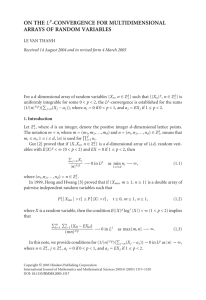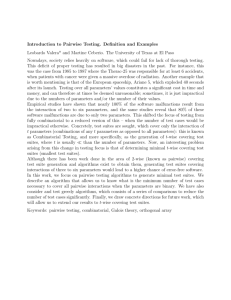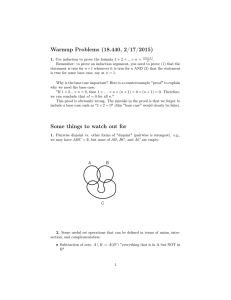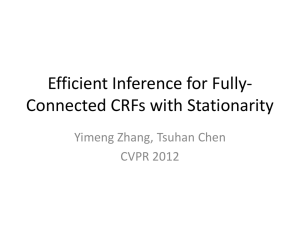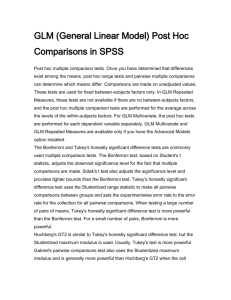OPERATION-SEPARATION AXIOMS IN BITOPOLOGICAL SPACES S.M. Al-Areefi
advertisement
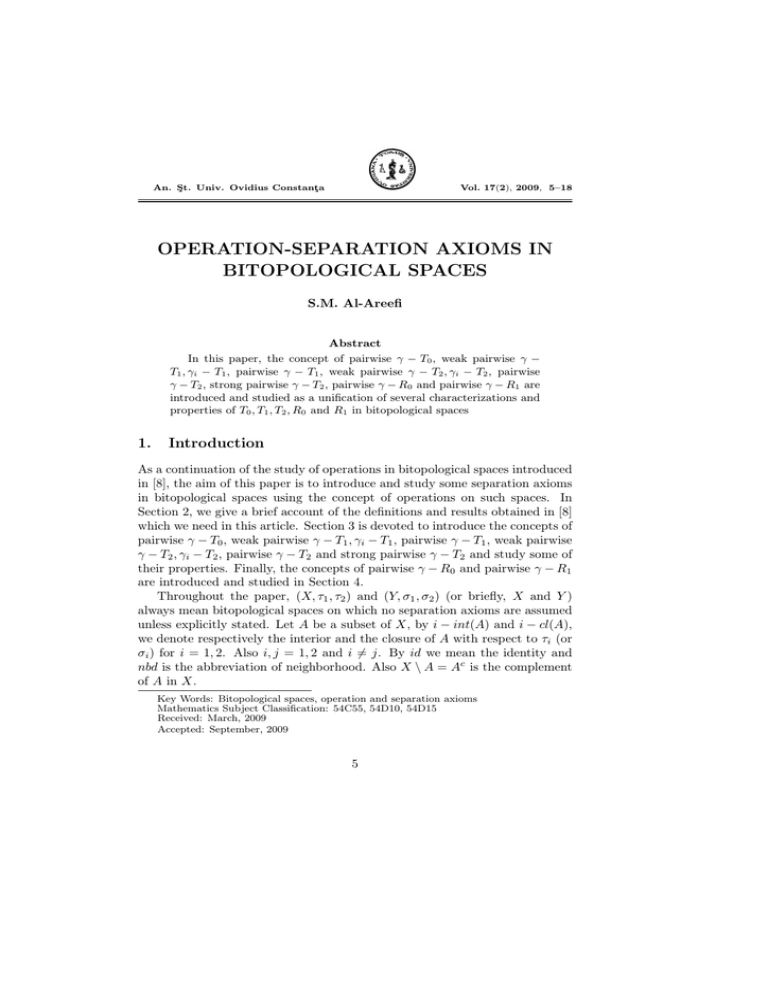
An. Şt. Univ. Ovidius Constanţa
Vol. 17(2), 2009, 5–18
OPERATION-SEPARATION AXIOMS IN
BITOPOLOGICAL SPACES
S.M. Al-Areefi
Abstract
In this paper, the concept of pairwise γ − T0 , weak pairwise γ −
T1 , γi − T1 , pairwise γ − T1 , weak pairwise γ − T2 , γi − T2 , pairwise
γ − T2 , strong pairwise γ − T2 , pairwise γ − R0 and pairwise γ − R1 are
introduced and studied as a unification of several characterizations and
properties of T0 , T1 , T2 , R0 and R1 in bitopological spaces
1.
Introduction
As a continuation of the study of operations in bitopological spaces introduced
in [8], the aim of this paper is to introduce and study some separation axioms
in bitopological spaces using the concept of operations on such spaces. In
Section 2, we give a brief account of the definitions and results obtained in [8]
which we need in this article. Section 3 is devoted to introduce the concepts of
pairwise γ − T0 , weak pairwise γ − T1 , γi − T1 , pairwise γ − T1 , weak pairwise
γ − T2 , γi − T2 , pairwise γ − T2 and strong pairwise γ − T2 and study some of
their properties. Finally, the concepts of pairwise γ − R0 and pairwise γ − R1
are introduced and studied in Section 4.
Throughout the paper, (X, τ1 , τ2 ) and (Y, σ1 , σ2 ) (or briefly, X and Y )
always mean bitopological spaces on which no separation axioms are assumed
unless explicitly stated. Let A be a subset of X, by i − int(A) and i − cl(A),
we denote respectively the interior and the closure of A with respect to τi (or
σi ) for i = 1, 2. Also i, j = 1, 2 and i 6= j. By id we mean the identity and
nbd is the abbreviation of neighborhood. Also X \ A = Ac is the complement
of A in X.
Key Words: Bitopological spaces, operation and separation axioms
Mathematics Subject Classification: 54C55, 54D10, 54D15
Received: March, 2009
Accepted: September, 2009
5
6
2.
S.M. Al-Areefi
Preliminary
Here, we give a brief account of the definitions and results obtained in [8]
which we need in this paper.
Definition 2.1. Let (X, τ1 , τ2 ) be a bitopological space. An operation γ on
τ1 ∪ τ2 is a mapping γ : τ1 ∪ τ2 → P (X) such that V ⊂ V γ for each V ∈ τ1 ∪ τ2 ,
where V γ denotes the value of γ at V . The operators γ(V ) = V, γ(V ) =
j − cl(V ) and γ(V ) = i − int(j − cl(V )) for V ∈ τi are operations in τ1 ∪ τ2 .
Definition 2.2. A subset A of a bitopological space (X, τ1 , τ2 ) will be called a
γi -open set if for each x ∈ A, there exists a τj - open set U such that x ∈ U and
U γ ⊂ A. τiγ will denote the set of all γi -open sets. Clearly we have τiγ ⊂ τi .
A subset B of X is said to be γi -closed if X \ B is γi -open in X.
If γ(u) = u (resp. j − cl(u)) and j − cl(i − int(u))) for each u ∈ Ti
then, the concept of γi -open sets coincides with the concept of τi -open (resp.
ij − o − open [3] and cj − δ−open [3] sets.
Definition 2.3. An operation γ on τ1 ∪ τ2 in (X, τ1 , τ2 ) is said to be i-regular
if for every pair U, V of τi -open nbds of each point x ∈ X, there exists a
τi -open nbd W of x such that W γ ⊂ U γ ∩ V γ . If γ is 1-regular and 2-regular
then it is called pairwise regular or, simply, regular.
Definition 2.4. An operation γ on (X, τ1 , τ2 ) is said to be i-open if for every
τi -open neighborhood U of each x ∈ X, there exists a γi -open set S such that
x ∈ S and S ⊂ U γ . If γ is 1-open and 2-open then it is called pairwise open
or, simply, open.
Example 2.5. Let X = {a, b, c} and let τ1 = τ2 = {φ, {a}, {b}, {a, b}, X}.
Let γ : τ1 ∪ τ2 → P (X) be an operation defined by γ(B) = i − cl(B) and
λ : τ1 ∪ τ2 → P (X) be an operation defined by λ(B) = i − int(j − cl(B)). Then
we have τiγ = {φ, X} and τ1λ = τi . It is easy to see that γ is i-regular but it
is not i-open on (X, τ1 , τ2 ).
Example 2.6. Let X = {a, b, c} and let τ1 = τ2 = {φ, X, {a}, {b}, {a, b}, {a, c}}.
For b ∈ X we define an operation γ : τ1 ∪ τ2 → P (X) by
A
if b ∈ A
γ(A) = Aγ =
i − cl(A)
if b 6∈ A
Then the operation γ : τ1 ∪ τ2 → P (X) is not regular on τ1 ∪ τ2 . In fact,
let U = {a} and V = {a, b} be i-open neighborhoods of a, then U γ ∩ V γ =
{a, c} ∩ {a, c} = {a} and W γ 6⊂ U γ ∩ V γ for any i-open neighborhood W of a.
OPERATION-SEPARATION AXIOMS IN BITOPOLOGICAL SPACES
7
Definition 2.7. Let γ, µ be two operations on τ1 ∪ τ2 in (X, τ1 , τ2 ). Then
(X, τ1 , τ2 ) is called (γ, µ)i -regular if for each x ∈ X and each τi -open nbd V of
x, there exists a τi -open set U containing x such that U γ ⊂ V µ . If µ = id, then
the (γ, µ)i -regular space is called γi -regular. If (X, τ1 , τ2 ) is (γ, µ)1 -regular and
(γ, µ)2 -regular, then it is called pairwise (γ, µ)-regular. Moreover, we can show
that this operation is i-open on τ1 ∪ τ2 .
In the rest of this paper, instead of “γ operation on τ1 ∪ τ2 in (X, τ1 , τ2 )”,
we shall say “γ operation on (X, τ1 , τ2 )”.
Proposition 2.8. Let γ be an operation on a bitopological space (X, τ1 , τ2 ).
Then (X, τ1 , τ2 ) is a γi -regular space if and only if τi = τiγ holds.
Proposition 2.9. Let γ be an i-regular operation on a bitopological space
(X, τ1 , τ2 ), then
(i) If A and B are γi -open sets of X, then A ∩ B is γi -open.
(ii) τiγ is a topology on X.
Remark 2.10. If γ is not i-regular, then the above proposition is not true in
general. In Exmaple 2.6, γ is not i-regular. In fact τiγ = {φ, X, {b}, {a, b}{a, c}}
which is not a topology on X.
Definition 2.11. Let γ be an operation on a bitopological space (X, τ1 , τ2 ).
A point x ∈ X is in the γi -closure of a set A ⊂ X if U γ ∩ A 6= φ for each
τi -open nbd U of x. The γi -closure of the set A is denoted by cliγ (A). A
subset A of X is said to be γi -closed (in the sense of cliγ (A)) if cliγ (A) ⊂ A.
Definition 2.12. Let A ⊂ (X, τ1 , τ2 ). For the family τiγ , we define a set
τiγ − cl(A) as follows:
τiγ − cl(A) = ∩{F : A ⊂ F, X \ F ∈ τiγ }.
Proposition 2.13. For a point x ∈ X, x ∈ τiγ −cl(A) if and only if V ∩A 6= φ
for any V ∈ τiγ such that x ∈ V .
Remark 2.14. It is easily shown that for any subset A of (X, τ1 , τ2 ), A ⊂
τi − cl(A) ⊂ cliγ (A) ⊂ τiγ − cl(A).
Theorem 2.15. Let γ be an operation on a bitopological space (X, τ1 , τ2 ),
then
(i) cliγ (A) is τi -closed in (X, τ1 , τ2 ).
(ii) If (X, τ1 , τ2 ) is γi -regular, then cliγ (A) = τi − cl(A) holds.
8
S.M. Al-Areefi
(iii) If γ is open, then cliγ (A) = τiγ − cl(A) and cliγ (cliγ (A)) = cliγ (A) hold
and cliγ (A) is γi -closed (in the sense of Definition 2.11).
Theorem 2.16. Let γ be an operation on a bitopological space (X, τ1 , τ2 ) and
A ⊂ X, then the following are equivalent:
(a) A is γi -open in (X, τ1 , τ2 ).
(b) cliγ (X \ A) = X \ A (i.e., X \ A is γi -closed in the sense of Definition
2.11).
(c) τiγ − cl(X \ A) = X \ A.
(d) X \ A is γi -closed (in the sense of Definition 2.12) in (X, τ1 , τ2 ).
Lemma 2.17. If γ is a regular operation on (X, τ1 , τ2 ), then cliγ (A ∪ B) =
cliγ (A) ∪ cliγ (B), for any subsets A and B of X.
Corollary 2.18. If γ is a regular and open operation on (X, τ1 , τ2 ), then cliγ
satisfies the Kuratowski closure axioms.
Definition 2.19. A mapping f : (X, τ1 , τ2 ) → (Y, σ1 , σ2 ) is said to be (γ, β)i continuous if for each point x of X and each σi -open set V containing f (x),
there exists a τi -open set U such that x ∈ U and f (U γ ) ⊂ V β . If f is (γ, β)i continuous for i = 1, 2, then it is called pairwise (γ, β)-continuous.
Example 2.20. If (γ, β) = (id, id) (resp. id, j − cl), (j − cl, id), (j − cl − j −
cl), (id, i−int◦j−cl), (i−int◦j−cl, id), (i−int◦j−cl, j−cl), (j−cl, i−int◦j−cl)
and (i − int ◦ j − cl, i − int ◦ j − cl)) then pairwise (γ, β)-continuity coincides with pairwise continuity [7] (resp. pairwise weak continuity [5], pairwise
strong θ-continuity [3], pairwise θ-continuity [4], pairwise almost continuity
[5], pairwise super continuity [9], pairwise weak θ-continuity [11], pairwise
almost strong θ-continuity [3] and pairwise δ-continuity [3]).
Proposition 2.21. Let f : (X, τ1 , τ2 ) → (Y, σ1 , σ2 ) be a (γ, β)i -continuous
mapping, then
(i) f (cliγ (A)) ⊂ cliβ (f (A)) for every A ⊂ X.
(ii) for any βi -closed set B of Y , f −1 (B) is γi -closed in X, i.e., for any
U ∈ σiβ , f −1 (U ) ∈ τiγ .
Definition 2.22. Let γ be an operation on a bitopological space (X, τ1 , τ2 ).
A subset K ⊂ X is said to be γi -compact if for every τi -open cover C of K,
n
[
Gγr .
there exists a finite subfamily {G1 , . . . , Gn } of C such that K ⊂
r=1
OPERATION-SEPARATION AXIOMS IN BITOPOLOGICAL SPACES
9
Example 2.23. If γ = id (resp. j − cl and i − int ◦ j − cl) then γi compactness
coincides with τi -compactness (resp. ij-almost-compactness [11] and ij-nearcompactness [3]).
Theorem 2.24. Let γ be an operation on a bitopological space (X, τ1 , τ2 ). If
X is γi -compact, then every cover of X by γi -open sets has a finite subcover.
If γ is open, then the converse is true.
3.
Pairwise γ − Tk Spaces
Definition 3.25. Let γ be an operation on a bitopological space (X, τ1 , τ2 ).
Then X is called pairwise γ − T0 if for any two distinct points of X, there
exists a subset which is either γi -open or γj -open containing one of the points
but not the other.
Example 3.26. In Definition 3.25, if γ = id, then we obtain the definition
of pairwise T0 spaces [6]. If γ(U ) = j − cl(U ) (resp. i − int(j − cl(U )) for
U ∈ τi , then pairwise γ − T0 spaces are called pairwise θ − T0 (resp. pairwise
δ − T0 ). If γ(U ) = i − int(i − cl(U )) for U ∈ τi , then we obtain pairwise rT0
spaces [2].
Theorem 3.27. Let γ be an operation on a bitopological space (X.τ1 , τ2 ). If
X is pairwise γ − T0 , then for any two distinct points x and y of X, there
exists a subset U which is either τi -open or τj -open containing one of them
(say x) such that y 6∈ U γ . If γ is open, then the converse is true.
Proof. Let x, y ∈ X such that x 6= y, then there exists a set U which is (say)
τiγ -open such that x ∈ U and y 6∈ U . Then there exists a τi -open set G
containing x such that Gγ ⊂ U . Obviously, y 6∈ Gγ . Now, if γ is open, let
x, y ∈ X such that x 6= y. Then, by assumption, there exists a τi -open set U
such that x ∈ U and y 6∈ U γ . Since γ is open, there exists a τiγ -open set S
such that x ∈ S and S ⊂ U γ . Obviously, y 6∈ S. This shows that X is pairwise
γ − T0 .
Theorem 3.28. Let γ be an operation on a bitopological space (X, τ1 , τ2 ).
Then X is pairwise γ − T0 if and only if for each two distinct points x and y
of X, either τiγ − cl{x} 6= τiγ − cl{y} or τjγ − cl{x} 6= τjγ − cl{y}.
Proof. Let X be a pairwise γ−T0 space and x, y ∈ X such that x 6= y. Suppose
U is a γi -open set containing x but not y. Then y ∈ τiγ − cl{y} ⊂ X \ U and so
x 6∈ τiγ − cl{y}. Hence τiγ − cl{x} 6= τiγ − cl{y}. Conversely, let x, y ∈ X such
that x 6= y. Then either τiγ − cl{x} 6= τiγ − cl{y} or τjγ − cl{x} 6= τjγ − cl{y}.
In the former case, let z ∈ X such that z ∈ τiγ − cl{y} and z 6∈ τiγ − cl{x}. We
10
S.M. Al-Areefi
assert that y 6∈ τiy − cl{x}. If y ∈ τiγ − cl{x}, then τiγ − cl{y} ⊂ τiγ − cl{x},
so z ∈ τiγ − cl{y} ⊂ τiγ − cl{x}, a contradiction. Hence y 6∈ τiγ − cl{x} and
therefore U = X \ τiγ − cl{x} is a γi -open set containing y but not x. The
case τjγ − cl{x} 6= τjγ − cl{y} can be dealt with similarly.
Corollary 3.29. A bitopological space (X, τ1 , τ2 ) is pairwise θ −T0 if and only
if for each two distinct points x and y of X, either ij − clθ {x} =
6 ij − clθ {y}
or ji − clθ {x} 6= ji − clθ {y}.
Corollary 3.30. A bitopological space (X, τ1 , τ2 ) is pairwise δ −T0 if and only
if each two distinct points x and y of X, either ij − clδ {x} =
6 ij − clδ {y} or
ji − clδ {x} 6= ji − clδ {y}.
Definition 3.31. Let γ be an operation on a bitopological space (X, τ1 , τ2 ).
Then X is called weakly pairwise γ − T1 if for any two distinct points x and
y of X, there exists a γi -open set U and a γj -open set V such that either
x ∈ U \ V and y ∈ V \ U or y ∈ U \ V and x ∈ V \ U .
Example 3.32. In Definition 3.31, if γ = id, then we obtain the definition
of weakly pairwise T1 [10]. If γ(U ) = j − cl(U ) (resp. i − int(j − cl(U ))) for
U ∈ τi , then weakly pairwise γ − T1 spaces are called weakly pairwise θ − T1
(resp. weakly pairwise δ − T1 ). If γ(U ) = i − int(i − cl(U )) for U ∈ τi , then
we obtain weakly pairwise rT1 spaces [2].
Theorem 3.33. Let γ be an operation on a bitopological space (X, τ1 , τ2 ).
Then the following are equivalent:
(i) (X, τ1 , τ2 ) is weakly pairwise γ − T1 .
(ii) τ1γ − cl{x} ∩ τ2γ − cl{x} = {x} for every x ∈ X.
(iii) For every x ∈ X, the intersection of all γ1 -open nbds and all γ2 -open
nbds of x is {x}.
Proof. (i) ⇒ (ii): Let x ∈ X and y ∈ τ1γ − cl{x} ∩ τ2γ − cl{x}, where y 6= x.
Since X is weakly pairwise γ − T1 , there exists a γ1 -open set U such that
y ∈ U, x 6∈ U or there exists a γ2 -open set V such that y ∈ V, x 6∈ V . In
either case, y 6∈ τ1γ −cl{x}∩τ2γ −cl{x}. Hence {x} = τ1γ −cl{x}∩τ2γ −cl{x}.
(ii) ⇒ (iii): If x, y ∈ X such that x 6= y, then x 6∈ τ1γ − cl{y} ∩ τ2γ − cl{y},
so there is a γ1 -open set or a γ2 -open set containing x but not y. Therefore y
does not belong to the intersection of all γ1 -open nbds and all γ2 -open nbds
of x.
(iii) ⇒ (i): Let x and y be two distinct points of X. By (iii), y does
not belong to a γ1 -nbd or a γ2 -nbd of x. Therefore there exists a γ1 -open or
a γ2 -open set containing x but not y. Hence x is a weakly pairwise γ − T1
space.
OPERATION-SEPARATION AXIOMS IN BITOPOLOGICAL SPACES
11
Corollary 3.34. For a bitopological space (X, τ1 , τ2 ), the following are equivalent:
(i) (X, τ1 , τ2 ) is weakly pairwise θ − T1 .
(ii) 12 − clθ {x} ∩ 21 − clθ {x} = {x} for every x ∈ X.
(iii) For every x ∈ X, the intersection of all 12 − θ-open nbds and all 21 − θopen nbds of x is {x}.
Corollary 3.35. For x ∈ X, the intersection of all 12 − δ-open neighborhoods
and all 21 − θ-open neighborhoods of x is {x}.
Theorem 3.36. Let γ be an operation on a bitopological space (X, τ1 , τ2 ). If
X is weakly pairwise γ − T1 , then for any two distinct points x and y of X,
there exists a τi -open set U and a τj -open set V such that either x ∈ U, y 6∈ U γ
and y ∈ V, = x 6∈ V γ or y ∈ U , x 6∈ U γ and x ∈ V, y 6∈ V γ . If γ is open, then
the converse is true.
Proof. Similar to that of Theorem 3.27.
Definition 3.37. Let γ be an operation on a bitopological space (X, τ1 , τ2 ).
Then X is called γi − T1 if for any two distinct points x and y of X, there
exist two γi -open sets U and V such that x ∈ U \ V and y ∈ V \ U . If X is
γ1 − T1 and γ2 − T1 , then it is called pairwise γ − T1 .
Example 3.38. In Definition 3.37, if γ = id, then we obtain the definition
of pairwise T1 [14]. If γ(U ) = j − cl(U ) (resp. i − int(j − cl(U ))) for U ∈ τi ,
then pairwise γ − T1 spaces are called pairwise θ − T1 (resp. pairwise δ − T1 )
and γi − T1 spaces are called ij − θ − T1 (resp. ij − δ − T1 ) spaces.
Theorem 3.39. Let γ be an operation on a bitopological space (X, τ1 , τ2 ).
Then X is γi − T1 if and only if τiγ − cl{x} = {x}, for every x ∈ X.
Proof. Let y 6∈ {x}, then y 6= x and there exists a τiγ -open set U such that
y ∈ U and x 6∈ U . Therefore y 6∈ τiγ − cl{x} and so τiγ − cl{x} = {x}.
Conversely, let x, y ∈ X such that x 6= y. Since τiγ − cl{x} = {x} and
τiγ − cl{y} = {y}, then there exists a γi -open set U and γi -open set V such
that x ∈ U \ V and y ∈ V \ U . Thus X is γi − T1 .
Corollary 3.40. Let γ be an operation on a bitopological space (X, τ1 , τ2 ).
Then X is pairwise γ − T1 if and only if τ1γ − cl{x} = {x} = τ2γ − cl{x}, for
every x ∈ X.
Corollary 3.41. A bitopological space (X, τ1 , τ2 ) is pairwise T1 if and only if
τ1 − cl{x} = {x} = τ2 − cl{x}, for every x ∈ X.
12
S.M. Al-Areefi
Corollary 3.42. A bitopological space (X, τ1 , τ2 ) is pairwise θ −T1 if and only
if 12 − clθ {x} = {x} = 21 − clθ {x}, for every x ∈ X.
Corollary 3.43. A bitopological space (X, τ1 , τ2 ) is pairwise δ −T1 if and only
if 12 − clδ {x} = {x} = 21 − clδ {x}, for every x ∈ X.
Definition 3.44. Let γ be an operation on a bitopological space (X, τ1 , τ2 ).
Then X is called weakly pairwise γ − T2 if for any two distinct points x and y
of X, there exist a γi -open set U and a disjoint γj -open set V such that x ∈ U
and y ∈ V or x ∈ V and y ∈ U .
Example 3.45. If γ = id in Definition 3.44, we obtain the definition weakly
pairwise T2 [15]. In case γ(U ) = j − cl(U ) (resp. i − int(j − cl(U ))) for
U ∈ τi , then weakly pairwise γ − T2 is called weakly pairwise θ − T2 (resp.
weakly pairwise δ − T2 ). If γ(U ) = i − int(i − cl(U )) for U ∈ τi , then we obtain
a pairwise semi rT2 [2].
Definition 3.46. Let γ be an operation on a bitopological space (X, τ1 , τ2 ).
Then X is called γi − T2 if for any two distinct points x and y of X, there
exist two disjoint γi -open sets U and V such that x ∈ U and y ∈ V . If X is
γ1 − T2 and γ2 − T2 , then it is called pairwise γ − T2 .
Definition 3.47. Let γ be an operation on a bitopological space (X, τ1 , τ2 ).
Then X is called strongly pairwise γ − T2 if for any two distinct points x and y
of X, there exist a γi -open set U and a disjoint γj -open set V such that x ∈ U
and y ∈ V .
Example 3.48. If γ = id in Definition 3.47, we obtain the definition pairwise
T2 [7]. In case γ(U ) = j − cl(U ) (resp. i − int(j − cl(U ))) for U ∈ τi , then
strongly pairwise γ − T2 is called strongly pairwise θ − T2 (resp. strongly
pairwise δ − T2 ). If γ(U ) = i − int(i − cl(U )) for U ∈ τi , then we obtain
pairwise rT2 [2].
Theorem 3.49. Let γ be an operation on a bitopological space (X, τ1 , τ2 ).
Then X is strongly pairwise γ − T2 if and only if the intersection of all γi closed γj -nbd of each point of X is reduced to that point.
Proof. Let X be strongly pairwise γ − T2 and x ∈ X. To each y ∈ X, x 6= y,
there exist a γi -open set G and a γj -open set H such that x ∈ H, y ∈ G and
G ∩ H = φ. Since x ∈ H ⊂ X \ G, therefore X \ G is γi -closed γj -nbd of
x to which y does not belong. Consequently, the intersection of all γi -closed
γj -nbds of X is reduced to {x}. Conversely, let x, y ∈ X such that x 6= y, then
by hypothesis, there exists a γi -closed γj -nbd U of x such that y 6∈ U . Now,
there exists a γi -open set G such that x ∈ G ⊂ U . Thus G is a γi -open set,
X \ U is a γj -open set, x ∈ G, y ∈ X \ U and G ∩ X \ U = φ. Hence X is
strongly pairwise γ − T2 .
13
OPERATION-SEPARATION AXIOMS IN BITOPOLOGICAL SPACES
Theorem 3.50. Let γ be an operation on a bitopological space (X, τ1 , τ2 ).
Then X is γi − T2 if and only if the intersection of all γi -closed γi -nbds of
each point of X is reduced to that point.
Proof. Similar to that of Theorem 3.49.
Theorem 3.51. Let γ be a regular operation on a strongly pairwise γ − T2
space (X, τ1 , τ2 ) and A ⊂ X a γi -compact. Then A is γj -closed.
Proof. If A = X, then A is obviously γj -closed. If A 6= X, then there is a
point x ∈ X \ A. Since X is strongly pairwise γ − T2 , for every y ∈ A, there
exist a γj -open set Uy and a γi -open set Vy such that x ∈ Uy , y ∈ Vy and
Uy ∩ Vy = φ. Then {Vy : y ∈ A} is a γi -open cover of A which is γi -compact,
n
[
Vyr . Let
then there exists a finite subfamily Vy1 , . . . , Vyn such that A ⊂
U=
n
\
r=1
Uyr and V =
n
[
r=1
Vyr . Since γ is regular, therefore U is a γj -open set,
r=1
V is a γi -open set, x ∈ U , A ⊂ V and U ∩ U = φ. Thus x ∈ U ⊂ X \ A and
so X \ A is γj -open and so A is γj -closed.
Corollary 3.52. If A is an ij-almost-compact subset of a strongly pairwise
θ − T2 space (X, τ1 , τ2 ), then A is ji − θ-closed.
Corollary 3.53. If A is an ij-nearly-compact subset of a strongly pairwise
δ − T2 space (X, τ1 , τ2 ), then A is ji − δ-closed.
Theorem 3.54. Let γ (resp. β) be an operation on a bitopological space
(X, τ1 , τ2 ) (resp. (Y, σ1 , σ2 )) and f : X → Y be a pairwise (γ, β)-continuous
injection. If Y is pairwise β − T0 (resp. weak pairwise β − T1 , βi − T1 , pairwise
β−T1 , weak pairwise β−T2 , βi −T2 , pairwise β−T2 and strong pairwise β−T2 ),
then X is pairwise γ − T0 (resp. weak pairwise γ − T1 , γi − T1 , pairwise γ − T1 ,
weak pairwise γ − T2 , γi − T2 , pairwise γ − T2 and strong pairwise γ − T2 ).
Proof. Suppose that Y is strong pairwise β − T2 and let x, y ∈ X such that
x 6= y. Then there exist a σiβ -open set U and a σjβ -open set V such that
f (x) ∈ U , f (y) ∈ V and U ∩ V = φ. Since f is pairwise (γ, β)-continuous,
by Proposition 2.21, f −1 (U ) is τiγ -open and f −1 (V ) is τjγ -open. Also, x ∈
f −1 (U ), y ∈ f −1 (V ) and f −1 (U ) ∩ f −1 (V ) = φ. This show that X is strong
pairwise γ − T2 . The proofs of the other cases are similar.
For different choices for γ and β in Theorem 3.54, we can write down a lot
of results, for example, we have the following
14
S.M. Al-Areefi
Corollary 3.55. If f : (X, τ1 , τ2 ) → (Y, σ1 , σ2 ) is pairwise weakly continuous
injection and Y is a strong pairwise θ−T2 space, then X is pairwise Hausdorff.
Corollary 3.56. If f : (X, τ1 , τ2 ) → (Y, σ2 , σ2 ) is pairwise almost continuous
injection and Y is a strong pairwise δ−T2 space, then X is pairwise Hausdorff.
Corollary 3.57. If f : (X, τ1 , τ2 ) → (Y, σ2 , σ2 ) is pairwise strongly θ-continuous
injection and Y is a pairwise Hausdorff space, then X is strong pairwise θ−T2 .
Corollary 3.58. If f : (X, τ1 , τ2 ) → (Y, σ2 , σ2 ) is pairwise super continuous
injection and Y is a pairwise Hausdorff space, then X is strong pairwise δ−T2 .
Corollary 3.59. If f : (X, τ1 , τ2 ) → (Y, σ2 , σ2 ) is pairwise θ-continuous injection and Y is a strong pairwise θ − T2 space, then X is strong pairwise
θ − T2 .
Corollary 3.60. If f : (X, τ1 , τ2 ) → (Y, σ2 , σ2 ) is pairwise weakly θ-continuous
injection and Y is a strong pairwise θ − T2 space, then X is strong pairwise
δ − T2 .
Definition 3.61. Let γ be an operation on a bitopological space (X, τ1 , τ2 )
and H ⊂ X, then the relative operation γ ∗ : τ1 /H ∪ τ2 /H → P (H) is an
∗
operation on (H, τ1 /H, τ2 /H) defined by (G ∩ H)γ = Gγ ∩ H for each G ∈
τ1 ∪ τ2 , where τi /H = {U ∩ H : U ∈ τi }.
Lemma 3.62. Let γ be an operation on a bitopological space (X, τ1 , τ2 ), H ⊂
X and γ ∗ be the relative operation in the subspace (H, τ1 /H, τ2 /H). If U is
γi -open in X, then U ∩ H is γi∗ -open in H.
Theorem 3.63. Every subspace of a pairwise γ − T0 (resp. weak pairwise
γ − T1 , γi − T1 , pairwise γ − T1 , weak pairwise γ − T2 , γi − T2 , pairwise γ − T2
and strong pairwise γ − T2 ) is a pairwise γ ∗ − T0 (resp. weak pairwise γ ∗ −
T1 , γi∗ − T1 , pairwise γ ∗ − T1 , weak pairwise γ ∗ − T2 , γi∗ − T2 , pairwise γ ∗ − T2
and strong pairwise γ ∗ − T2 ).
Proof. Follows directly from Lemma 3.62.
Remark 3.64. The argument of Theorem 3.36 is true for the cases of weak
pairwise γ − T1 , γi − T1 , pairwise γ − T1 , weak pairwise γ − T2 , γi − T2 , pairwise
γ − T2 and strong pairwise γ − T2 spaces.
For different choices for γ in Remark 3.64, we can write down a lot of
results, for example, we have the following
OPERATION-SEPARATION AXIOMS IN BITOPOLOGICAL SPACES
15
Corollary 3.65. A bitopological space (X, τ1 , τ2 ) is weak pairwise δ − T1 if
and only if for any two distinct points x and y of X, there exist a τi -open
set U and a τj -open set V such that either x ∈ U, y 6∈ i − int(j − cl(U ))
and y ∈ V, x 6∈ j − int(i − cl(V )) or y ∈ U , x 6∈ i − int(j − cl(U )) and
x ∈ V, y 6∈ j − int(i − cl(V )).
Corollary 3.66. A bitopological space (X, τ1 , τ2 ) is weak pairwise δ − T2 if
and only if for any two distinct points x and y of X, there exist a τi -open set
U and a τj -open set V such that either x ∈ U and y ∈ V or y ∈ U , and x ∈ V
and i − int(j − cl(U )) ∩ j − int(i − cl(V )) = φ.
Corollary 3.67. A bitopological space (X, τ1 , τ2 ) is strong pairwise δ − T2 if
and only if for any two distinct points x and y of X, there exist a τi -open set
U and a τj -open set V such that x ∈ U, y ∈ V , and i − int(j − cl(U )) ∩ j −
int(i − cl(V )) = φ.
Theorem 3.68. Let γ be an open and regular operation on a bitopological
space (X, τ1 , τ2 ). Then (X, τ1 , τ2 ) is pairwise γ − T0 (resp. weak pairwise
γ − T1 , pairwise γ − T1 , weak pairwise γ − T2 and strong pairwise γ − T2 ) if
and only if (X, τ1γ , τ2γ ) is pairwise T0 (resp. weak pairwise T1 , pairwise T1 ,
weak pairwise T2 , and strong pairwise T2 ).
Proof. It is straight forward by Proposition 2.9 and Remark 3.64
For different choices for γ in Theorem 3.68, we can write down a lot of
results, for example, we have the following
Corollary 3.69. A bitopological space (X, τ1 , τ2 ) is pairwise δ −T0 if and only
if (X, τ1δ , τ2δ ) is pairwise T0 .
Corollary 3.70. A bitopological space (X, τ1 , τ2 ) is pairwise δ −T1 if and only
if (X, τ1δ , τ2δ ) is pairwise T1 .
Corollary 3.71. A bitopological space (X, τ1 , τ2 ) is strong pairwise δ − T2 if
and only if (X, τ1δ , τ2δ ) is strong pairwise T2 .
We finish this section by investigating general operator approaches of closed
graphs of mappings.
Definition 3.72. [13] Let (X, τ1 , τ2 ) and (Y, σ, σ2 ) be two bitopological spaces.
The cross product of the two spaces X and Y is defined to be the space
(X × Y, µ1 , µ2 ), where µi = τi × σj .
Definition 3.73. Let γ (resp. β) be an operation on the bitopological space
(X, τ1 , τ2 ) (resp. (Y, σ1 , σ2 )). An operation ρ : τ1 × σ2 ∪ τ2 × σ1 → P (X × Y ) is
16
S.M. Al-Areefi
said to be associated with γ and β if (U × V )ρ = U γ × V β for each U ∈ τi and
V ∈ σj . ρ is called regular with respect to γ and β if for each (x, y) ∈ X × Y
and each µj -open nbd W of (x, y), there exist a τi -open nbd U of x and a
σj -open nbd V of y such that W ρ ⊂ U γ × V β .
Theorem 3.74. Let ρ be an operation on X × X associated with γ and γ. If
f : X → Y is a pairwise (γ, β)-continuous mapping and (Y, σ1 , σ2 ) is a strong
pairwise β − T2 space, then the set A = {(x, y) ∈ X × X : f (x) = f (y)} is a
ρi -closed subset of X × X.
Proof. We show that cliρ (A) ⊂ A. Let (x, y) ∈ X × X \ A. Then there
exist a σi -open set U and a σj -open set V such that f (x) ∈ U, f (y) ∈ V
and U β ∩ V β = φ. Moreover, there exist a τi -open set W and a τj -open set
S such that x ∈ W, y ∈ S and f (W γ ) ⊂ U β and f (S γ ) ⊂ V β . Therefore,
(W × S)ρ ∩ A = φ. This shows that (x, y) 6∈ cliρ (A) and so cliρ (A) ⊂ A.
Corollary 3.75. Let ρ be an operation on X × X associated with γ and γ
which is regular with respect to γ and γ. A space X is strong pairwise γ − T2
if and only if the diagonal set ∆ = {(x, x) : x ∈ X} is ρi -closed in X × Y .
Theorem 3.76. Let ρ be an operation on X × Y associated with γ and β. If
f : X → Y is a pairwise (γ, β)-continuous mapping and (Y, σ1 , σ2 ) is a strong
pairwise β − T2 space, then the graph of f , G(f ) = {(x, f (x)) ∈ X × Y } is a
ρi -closed subset of X × Y .
Proof. The proof is similar to that of Theorem 3.74
References
[1] Abd El-Monsef, M.E. Kozae, A.M. and Taher, B.M., Compactification in
bitopological spaces, Arab J. for Sci. Engin., 22(1A)(1997), 99–105.
[2] Arya, S.P. and Nour, T.M., Separation axioms for bitopological spaces,
Indian J. Pure Appl. Math., 19(1)(1988), 42–50.
[3] Banerjee, G.K., On pairwise almost strongly θ-continuous mappings, Bull.
Calcutta Math. Soc., 79(1987), 314–320.
[4] Bose, S. and Sinha, D., Almost open, almost closed, θ-continuous and
almost quasi compact mappings in bitopological spaces, Bull. Calcutta
Math. Soc., 73(1981), 345–356.
[5] Bose, S. and Sinha, D., Pairwise almost continuous map and weakly continuous map in bitopological spaces, Bull. Calcutta Math. Soc., 74(1982),
195–205.
OPERATION-SEPARATION AXIOMS IN BITOPOLOGICAL SPACES
17
[6] Fletcher, P., Hoyle, H.B. III and Patty, C.W., The comparison of topologies, Duke Math. J., 36(2)(1969), 325–331.
[7] Kelly, J.C., Bitopological spaces, Proc. London Math. Soc., (3)13(1963),
7–89.
[8] Khedr, F.H., Operations on bitopological spaces (submitted).
[9] Khedr, F.H. and Al-Shibani, A.M., On pairwise super continuous mappings in bitoplogical spaces, Internat. J. Math. Math. Sci., (4)14(1991),
715–722.
[10] Misra, D., N., and Dube, K.K., Pairwise R0 -spaces, Ann de la Soc. Sci,
Bruxells, T. 87(1)(1973), 3–15.
[11] Mukherjee, M.N., On pairwise almost compactness and pairwise Hclosedness in a bitopologicla space, Ann. Soc. Sci. Bruxelles, T. 96,
2(1982), 98–106.
[12] Murdeshware, M.G. and Namipally, S.A., Quasi-uniform topological
spaces, Monograph, P. Noordoff Ltd. (1966).
[13] Nandi, J.N. and Mukherjee, M.N., Bitopological δ-cluster sts and some
applications, Indiana J. Pure Appl. Math., 29(8)(1998), 837–848.
[14] Reilly, I.L., On bitopological separation properties, Nanta Math.,
5(2)(1972), 14–25.
[15] Smithson, R.E., Mutlifunctions and bitopological spaces, J. Nat. Sci.
Math., 11(2)(1971), 191–198.
[16] Swart, J., Total disconnectedness in bitopological spaces and product
bitopological spaces, Proc. Kon. Ned. Akad Wetench A 74 = Indag.
Math., 33(2)(1971), 135–145.
Faculty of Science
Department of Mathematics
P.O. Box 838, Dammam 31113, Kingdom of Saudi Arabia
Email: s.alareefi@yahoo.com
18
S.M. Al-Areefi
